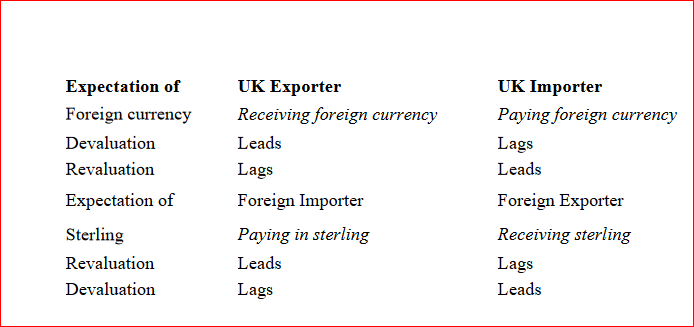There are four main internal means of reducing exchange rate exposure. These are based on methods of processing transactions and payments, and of offsetting assets and liabilities in different currencies.
a)Currency invoicing
The first approach is simply to invoice foreign customers in the currency of the seller. Invoicing for goods supplied, and paying for goods received, in a company’s domestic currency removes the exchange rate risk for that company -but only one party to an exchange between foreign companies can have this facility, and the other bears the risk of exchange rate fluctuations. However, the advantages of removing exchange rate risk need to be weighed against those of invoicing in the foreign currency. These include marketing advantages such as the ease for the customer of dealing in his own currency and the possibility of purchasing at a discount if the foreign currency is depreciating relative to the domestic currency. In fact, often the only way to win a contract overseas is to deal in the currency of that market. One way to prevent one or both parties being subject to exchange rate risk is for the firms involved to set a level of exchange rate to use for a transaction regardless of what the actual exchange rate is on the day the money is transferred.
b)Netting
This is an internal settlement system used by multinational companies with overseas subsidiaries. It involves offsetting (netting out) the outstanding foreign exchange positions of subsidiaries against each other through a central point -the group treasury. Suppose there are two overseas subsidiaries in different countries. Subsidiary A expects to receive a payment in one month’s time for the sale of goods to the value of $2m, while subsidiary B has to make a payment of $3m in one month’s time to a supplier. The central treasury can offset the two exposures and set up an external hedge for the net risk of $1 m. This negates the need for two separate hedges to be carried out -the first to cover the $3m against a rise in exchange rates against the dollar and second to cover the $2m against a fall in exchange rates against the dollar. The single hedge is more efficient and cost-effective.
c)Matching
This is the process of matching receipts in a particular currency with payments in the same currency. This prevents the need to buy or sell the foreign currency and thus reduces exchange rate risk to the surplus or deficit the firm has of the foreign currency. It is a cheap method of reducing or eliminating exchange rate risk provided that the receipts precede the payments, and the time difference between the two is not too long. For example, where a company is selling to the US and has outstanding receipts denominated in $, it could purchase raw materials in the same currency. The one transaction will offset the other and minimize the exchange exposure that requires external hedging. It therefore does not matter whether the $ strengthens or weakens against the domestic currency. Alternatively, a firm could match, say, dollar currency receipts from the export of goods to the US with a dollar loan. The receipts will be used to payoff the loan. This again secures the matching of an asset with a liability. This process can be made easier either by having a bank account in the foreign country or a foreign currency account in a firm’s own country, and putting in all receipts and taking from it all payments in the overseas currency. The exchange rate risk on the surplus or deficit can be avoided by utilizing one of the other methods of risk management. Matching may also be used to reduce translation exposure -offsetting an investment in assets in one currency with a corresponding liability in the same currency. For example, the acquisition of an asset denominated in Yen could be achieved by borrowing funds in Yen. As the exchange rate against the Yen varies, the effect it has on the translated value of the asset and liability will increase and decrease in concert. The amount of the reduction in exposure will depend on the extent to which the expected economic life of the asset corresponds with when the loan matures.
d)Leads and Lags
This final method of hedging internally involves varying payment dates to take advantage of the exchange rate -for example, paying either before or after the due date, depending on exchange rate movements. The effectiveness of this is dependent on how well exchange rate movements can be anticipated. A company will only pay in advance if it expects the domestic currency to weaken, but if it misreads the movement and the exchange rate strengthens, advance payment may prove expensive. Leads are advance payments for imports to avoid the risk of having to pay more local currency if the supplier’s currency increases in value.
Lags involve slowing down the exchange of foreign receipts by exporters who anticipate a rise in the value of the foreign currency received. When this occurs, they will then benefit by an exchange rate in their favour. The table below shows the scope for leading and lagging by financial managers of importers or exporters.

A UK exporter would accelerate (lead) his receipts in the event of an anticipated devaluation, but he would delay (lag) his foreign receipts if a revaluation was expected, and so forth. In leading, he will need to borrow or otherwise raise the cash which will involve a cost of capital, whilst lagging will attract interest as there will be surplus for investment.
